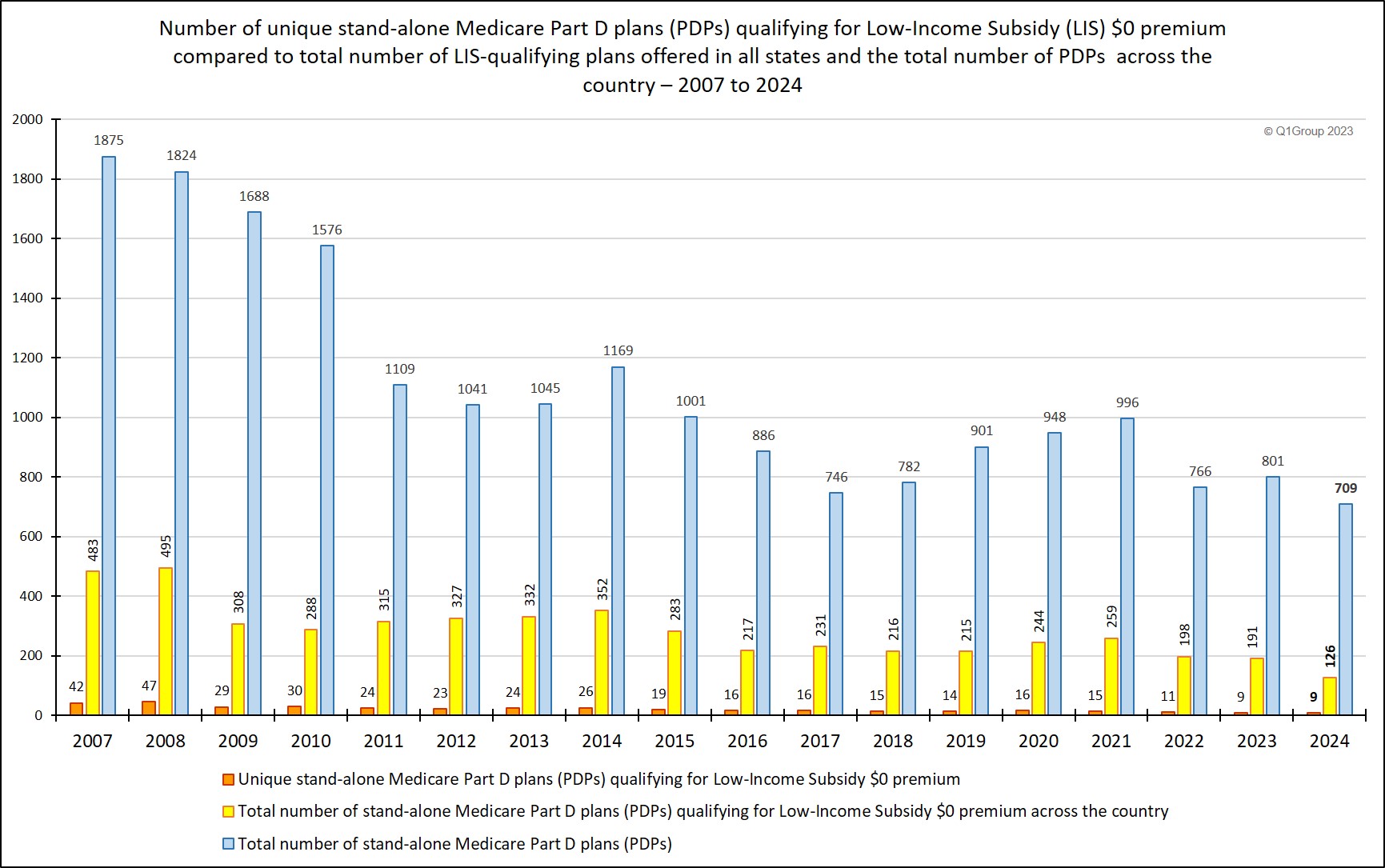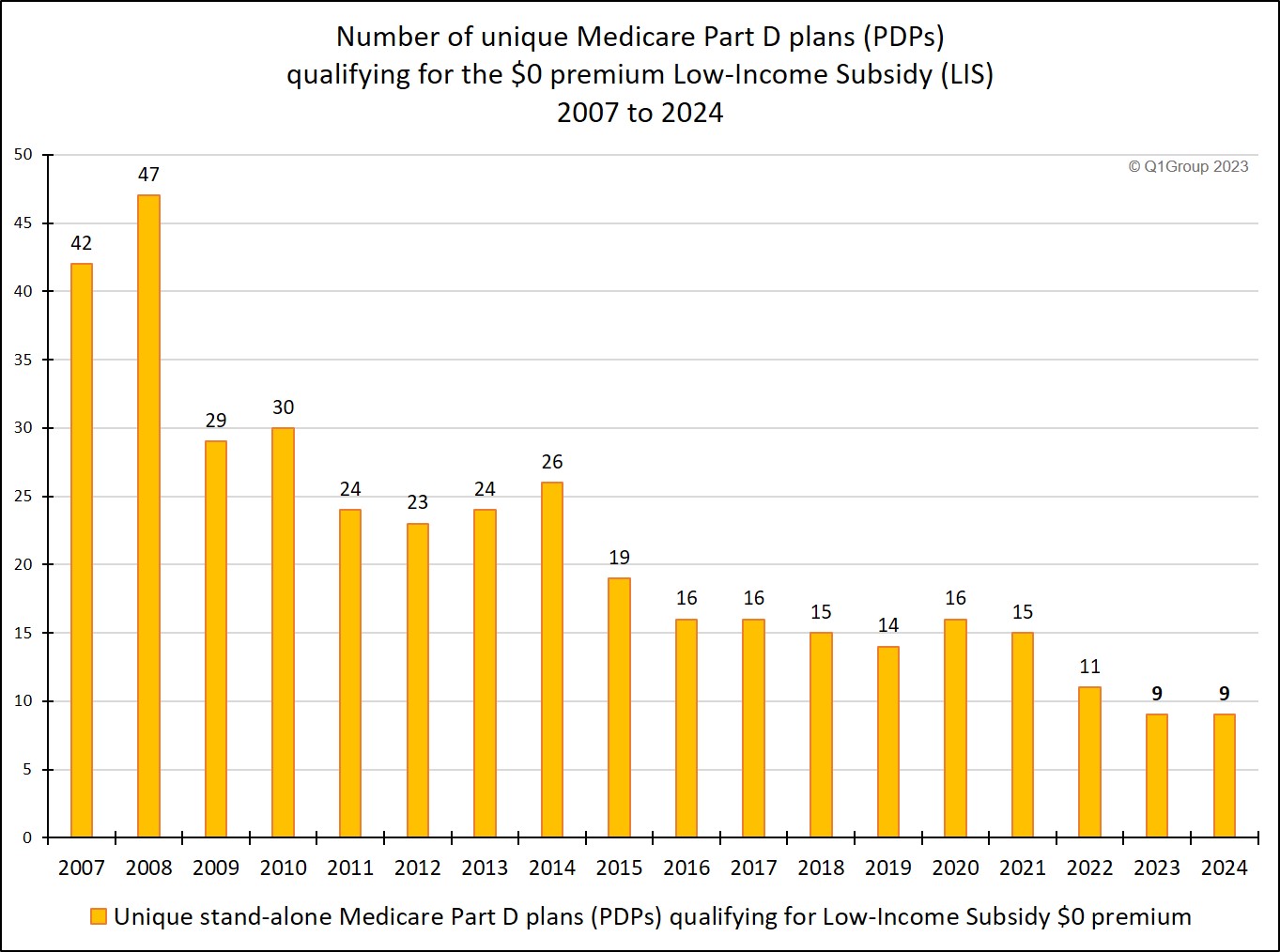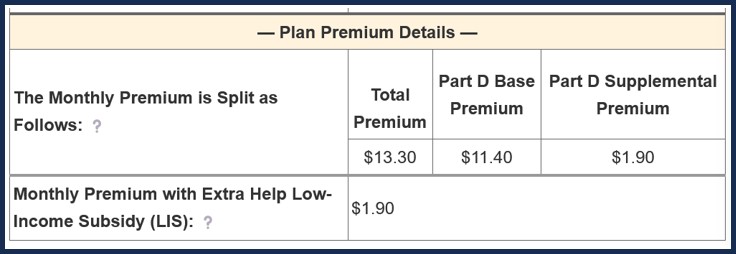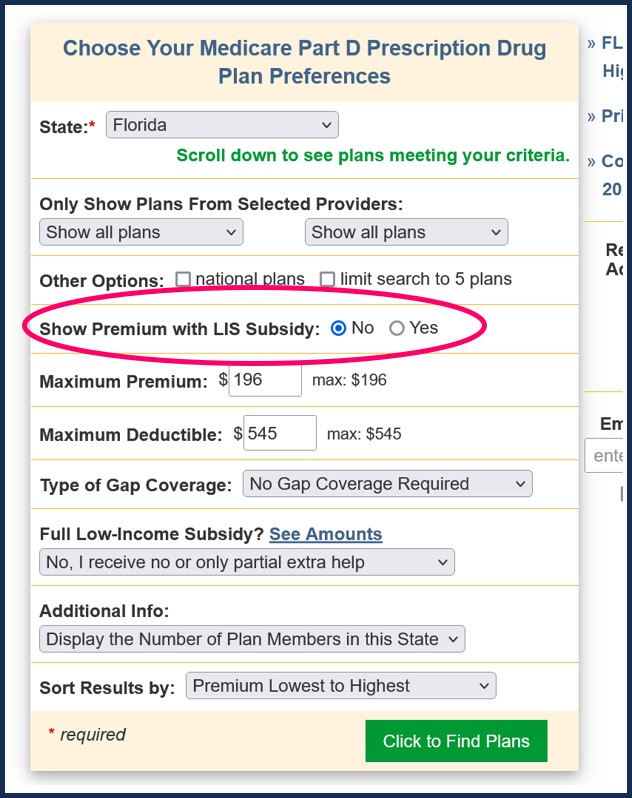On September 26, 2023, the Centers for Medicare and Medicaid Services (CMS) released
the 2024
Medicare Part D prescription drug plan landscape data and "announced that average premiums, benefits, and plan choices for
Medicare Advantage and the Medicare Part D prescription drug program
will remain stable in 2024."
Our preliminary analysis of the Medicare Part D prescription drug plan (PDP) landscape shows significantly fewer 2024 stand-alone Medicare Part D PDP options and
the total number of 2024 PDPs qualifying for the Low-Income Subsidy (LIS) $0 premium will also decrease to a historic low,
with all but two states offering fewer $0 premium LIS-qualifying 2024 drug plan options.
The total number of stand-alone 2024 Medicare Part D prescription drug
plans across the country
will decrease 11.5% to 709
plans from 801 plans currently offered in 2023. The total number of PDPs offered across the country is the lowest since the 2006 start of the Medicare Part D program. In addition, the total number of $0 premium LIS-qualifying PDPs
decreased to its lowest level in 2024 (see chart below) from 191 qualifying plans in 2023 to 126 LIS $0 premium plans in 2024.

Number of unique 2024 $0 premium LIS Part D plans remains the same, but most states will lose $0 premium LIS plan options.
On a positive note, the number of unique 2024 Medicare Part D plans that qualify for the LIS $0 premium remains at nine (9) prescription drug plans - the lowest level since the start of the Medicare Part D program.
Unfortunately, most states will lose Medicare Part D plans qualify for the Low-Income Subsidy (LIS) $0 premium benchmark in 2024 as compared to 2023.
Overall,
two (2) states will continue to have the same number of options,
twenty-two (22) states will lose one (1) LIS qualifying plan option, and
twenty-seven (27) states will lose two (2) to five (5) LIS qualifying plan options.

As an example of state plan changes, Illinois will offer two (2) LIS $0 premium qualifying 2024 Medicare Part D plans as compared to the seven (7) LIS-qualifying plans in 2023.
- The states with the smallest selection of $0-premium LIS 2024 Medicare Part D plans include . . .
The states with the smallest selection of 2024 Medicare Part D plans qualifying for the
LIS $0 premium are
Florida,
Illinois,
Missouri,
Nevada,
New Jersey,
New York,
Ohio, and
Texas
-- each offering only two (2) LIS $0-premium qualifying Medicare Part D plans.
-
The state with the largest selection of LIS-qualifying $0 premium Medicare Part D plans is . . .
The state offering the largest selection of $0 premium LIS plans is Wisconsin whose residents will have seven (7) LIS plan options.
- The state with the largest number of LIS recipients is . . .
Question: Which Medicare Part D plan providers are offering 2024 LIS-qualifying plans?
From our national stand-alone PDP-Facts page, here is a table showing a comparison of the nine 2023 and 2024 Medicare Part D plans qualifying for the $0 premium Low-Income Subsidy. 2023 $0 premium LIS qualifying plans no longer offering $0 LIS plans in 2024 are highlighted in green. Medicare Part D plans now offering $0 premium LIS plans in 2024 are highlighted in yellow.
$0 Premium LIS Qualified stand-alone 2024 Medicare Part D Plans (as compared to 2023)
|
|
||||||||||||||||||||||||||||||||||||||||||||
Note: Not all Medicare Part D plans are available in every state. You can click the chart heading above to see plan details in California (as an example state) or choose your state from the on the CA page.
Historical changes in the total number of LIS-qualifying Medicare Part D plans
Over the past few years, the number of Medicare Part D plans qualifying for the $0-premium Low-Income Subsidy stayed somewhat consistent, averaging between 14 to 16 plans each year.
However, in 2022 and 2023, there was a meaningful reduction in the number of LIS-qualifying plans - and 2024 follows with a further reduction to the historically lowest total number of LIS $0 premium plans.
- Two (2) states have no change in the number of LIS $0 premium plans being offered
- Twenty-two (22) states are losing one LIS $0 premium plan
- Twenty-seven (27) states are losing two (2) to five (5) LIS $0 premium plan
- Arizona, and
New Jersey
will each lose four (4) LIS qualifying plan options, and Illinois
will lose five (5) LIS qualifying plan options.
- Wisconsin will to have the most LIS $0 premium plan options seven (7).
Question: Which Medicare Part D plans qualify for the full Low-Income Subsidy $0 premium in my state?
Each year, insurance companies adjust their Medicare Part D plan premiums, and some Medicare Part D plans raise their premiums and move their prescription drug plans above the state low-income subsidy (LIS) benchmark limits, while other Part D plan sponsors lower their monthly premiums so that their plans can qualify for a state’s $0 premium.
This means that the number of Medicare Part D plans qualifying for the LIS $0 premium can change each year. Click on the 2024 premium for your state in our state low-income subsidy (LIS) benchmark limits article to see qualifying plans in your state.
More on the Medicare Part D Extra Help or Low-Income Subsidy (LIS) program
The Medicare Part D Extra Help or the Low-Income Subsidy (LIS)
is a federal program helping low-income Medicare beneficiaries pay a portion of their
Medicare Part D prescription drug costs. The Extra Help or LIS program pays the beneficiary’s monthly
Medicare Part D plan premiums and a significant portion of the beneficiary’s medication costs.
If you qualify for the LIS program, you can choose a Medicare Part D plan that qualifies
for your state’s $0 monthly premium or allow yourself to be automatically enrolled in a
plan that qualifies for the $0 premium. If you enroll in a Medicare Part D plan that does
not qualify for the $0 premium, you will pay a portion of the premium. If you choose your own Medicare Part D plan, the monthly premium
amount you will pay is shown under the "Benefit Details" button on our Medicare Part D plan finder.

Please note, our Medicare Part D plan finder allows you to view the premiums
of a Medicare Part D plan based on whether you receive LIS benefits.
The PDP-Finder.com feature looks like this:

A Brief note about automatic plan reassignment and people who are "choosers"
Because of changes in the annual Medicare Part D plan premiums and state LIS benchmarks,
some low-income subsidy qualifying Medicare beneficiaries (such as people who are
Medicare/Medicaid dual-eligible beneficiaries) may be automatically reassigned to new
2024 Medicare Part D plans that will still qualify for the $0 monthly premium.
However, Extra Help recipients who "chose" their own plan in the past
(these beneficiaries are also referred to as "choosers") may
not be auto-reassigned to a new
2024 LIS qualifying plan and may need to select a new
2024 Medicare Part D plan or Medicare Advantage plan that includes drug coverage that still
meets the $0 monthly premium threshold (or pay the small monthly premium).
As reference, you can use our
PDP-Finder to see LIS qualifying plans
in your state. Be sure to select "Yes, show only plans that qualify for $0 premium". Click here to see an example for Texas.
Not sure where to begin?
For more information on Medicare Part D plans that qualify for your state's low-income $0 premium benchmark, please call Medicare toll-free at 1-800-633-4227 and speak with a Medicare representative to learn more about your Medicare Part D and Medicare Advantage plan options.
- Sign-up for our Medicare Part D Newsletter.
- PDP-Facts: 2024 Medicare Part D plan Facts & Figures
- 2024 PDP-Finder: Medicare Part D (Drug Only) Plan Finder
- PDP-Compare: 2023/2024 Medicare Part D plan changes
- 2024 MA-Finder: Medicare Advantage Plan Finder
- MA plan changes 2023 to 2024
- Drug Finder: 2024 Medicare Part D drug search
- Formulary Browser: View any 2024 Medicare plan's drug list
- 2024 Browse Drugs By Letter
- Guide to 2023/2024 Mailings from CMS, Social Security and Plans
- Out-of-Pocket Cost Calculator
- Q1Medicare FAQs: Most Read and Newest Questions & Answers
- Q1Medicare News: Latest Articles
- 2025 Medicare Part D Reminder Service
